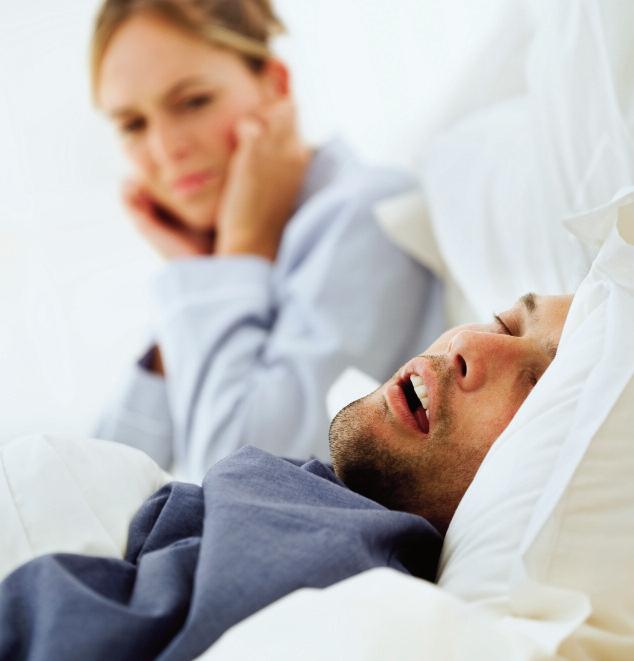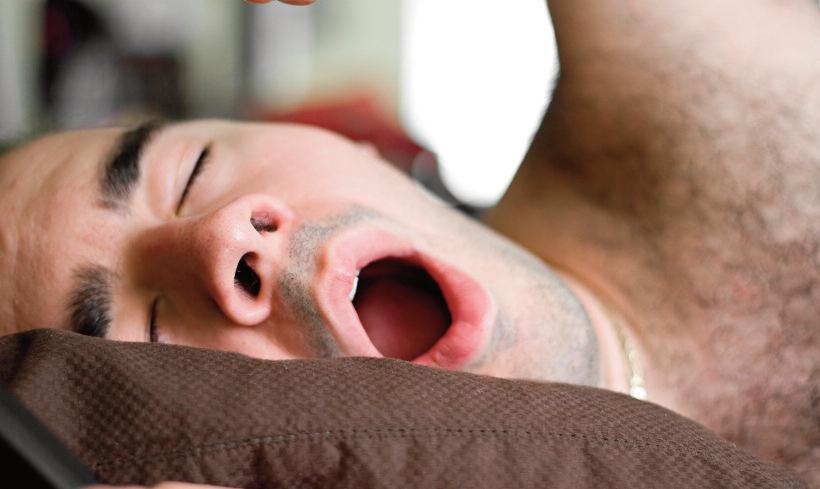
13 minute read
THE ROLE OF THE NOSE IN SNORING AND OBSTRUCTIVE SLEEP APNEA: THE PROBLEM AND SOLUTIONS

Advertisement
W R I T T E N B Y S A M U E L N . H E L M A N , B . S C . / S T E V E N Y. PA R K , M . D .
SNORE NO MORE!
SN O R I N G H A S P L A G U E D O U R S O C I E T Y F O R G E N E R A T I O N S . Indeed, this cacophonous phenomenon has been the ire of bed-partners and passers-by alike. In the late 1800s, American gunslinger and outlaw John Wesley Hardin famously shot at the bedroom of a snoring gentleman staying at the same hotel.
1
Besides being an auditory nuisance, snoring has serious implications for the snorer and bed-partner. Snoring is often a symptom of obstructive sleep apnea (OSA), a condition that can have devastating consequences for your health, including an increased risk of hypertension, heart disease, diabetes, depression, and obesity. OSA has also been associated with higher rates of heart attack and stroke.

Snoring is often believed to be caused by nasal congestion; there are numerous examples of companies and physicians primarily targeting nasal congestion to relieve snoring and sleep apnea. Their efforts are not completely in vain, since nasal congestion is commonly found in snorers and patients with OSA, and obstructed nasal breathing is a strong risk factor for OSA. 2,3,4
As far back as 1889, William Hill advocated treating nasal congestion as a means of curing “ stupid children. ” George Catlin, an American painter in the Civil War era, observed that American Indians, who were nasal breathers, were healthier and less prone to infection. 5,6 However, recent research indicates that the answer is not so clear-cut. While treating nasal congestion can alleviate sleep-related breathing disorders, overall results in the research literature have been mixed. This article will review the role of nose in snoring and obstructive sleep apnea and highlight some relationships between treatment for nasal disorders and OSA.

GETTING TO KNOW THE NOSE
From the outside, the nose appears to be an unassuming structure. However, the interior of the nose is remarkably complex. The nasal cavity is separated by a bone and cartilage-containing structure called the nasal septum. Inside the nose, nostrils (technically called nasal turbinates) smooth airflow, humidify, filter and heat air, and even have an antibacterial effect by releasing bacteria-toxic nitric oxide. 7 The turbinates are surrounded by soft tissue.
When the sympathetic nervous system, which is part of the autonomic nervous system responsible for the so-called fight or flight response, is activated, the turbinates receive less blood supply and decrease in size. You may have experienced this phenomenon when you had a stuffy nose that was relieved by exercise, as the sympathetic system gets revved up during physical activity. Alternatively, when the parasympathetic or antisympathetic nervous system is activated, the turbinates distend and swell, causing nasal congestion. Many blood pressure medications trigger this anti-sympathetic effect and can cause nasal congestion.
The nose typically cycles between stages of congestion and decongestion without causing any perceptible problems for an individual. However, narrow nasal passages can result in bothersome symptoms during the congestion cycle. Additionally, in some individuals with autonomic nervous system abnormalities, the nasal cycle can lose its normal regulation and lead to obstructive sleep apnea (OSA).
8
The nasal entrance is the narrowest point in the human upper airway and has the highest amount of airway resistance. Skin, cartilage, muscle, and other soft tissue reinforce this valve to prevent it from collapsing during breathing. However, ethnic origins, internal nasal factors, and a history of surgeries such as rhinoplasty can cause the soft tissue envelope of the nostrils to collapse by varying degrees. Nasal collapse can exacerbate nasal congestion caused by other conditions, such as polyps, chronic sinusitis, enlarged adenoid glands, upper respiratory tract infection, and allergic or nonallergic inflammation of the nostrils.
If an individual is susceptible, having a stuffy nose can trigger sleep apnea. Imagine breathing through a narrow straw. If air is pulled in slowly, a small amount of air comes through. However, if you breathe too hard, the straw collapses. In the case of the upper airway, partial or total obstruction of the nose can lead to collapse of downstream structures such as the soft palate or the base of the tongue.

THE ORIGINS OF A LIFE-LONG PROBLEM
Some difficulties with nasal passages and breathing can begin during infanthood. A newborn, shortly after announcing his arrival with an ear-shattering yowl, breathes exclusively through his nose during the first four to six months of life. For some infants, a deviated nasal septum, which can follow trauma to the nose when an infant is delivered from the birth canal, is associated with poor positioning of the jaws and teeth and hence a higher chance of nasal congestion.
9
“ ...mouth breathing is associated with up to two and a half times higher airway resistance and lower oxygen uptake in the lungs when compared to nasal breathing.

Samuel N. Helman
Samuel N. Helman completed his bachelor ’ s degree in Neuroscience at McGill University and is currently a fourth-year medical student at Albert
Einstein College of
Medicine of Yeshiva
University in New York. Helman ' s research interests include obstructive sleep apnea, angioedema and airway management, head and neck oncology, craniofacial reconstruction, and general otolaryngology. Infants begin mouth breathing after a process called laryngeal descent, when the epiglottis and voice box begins to separate from the soft palate. 10 At the same time, the widening of the arch of the mouth in general may depend on the way the child is fed. One study revealed that communities in the United States that fed their children soft foods instead of hard foods had higher rates of dental crowding and narrowed upper and lower jaws. 11 Bottlefeeding has also been shown to cause greater rates of dental crowding and narrowed dental arches. 12 This in turn produces crowding of the soft tissues of the mouth and nose such as the tongue, the nasal turbinates, and septum.
NASAL OBSTRUCTION AND SNORING
Contrary to the prevalent view that snoring comes solely from nasal obstruction, the offending vibrations in fact originate from the uvula and soft palate. With heavy snoring, other structures, such as the tonsils, the epiglottis, and tongue base, can vibrate. It is commonly believed that snoring and sleep apnea are one in the same. However, snoring is simply the vibration of sound across soft tissues, whereas apnea is the arrest of breathing during sleep. Obstructive sleep apnea is more related to health problems, but snoring has also been associated with behavioral troubles in childhood and a higher rate of carotid artery atherosclerosis. 13,14
NASAL OBSTRUCTION AND SLEEP APNEA
Multiple studies indicate that nasal congestion leads to apnea events, worsened sleep quality, disturbed sleep breathing patterns, and fragmented sleep cycles. 15,16,17,18,19 When a person ’ s nose is congested, he must breathe through his mouth. However, mouth breathing is associated with up to two and a half times higher airway resistance and lower oxygen uptake in the lungs when compared to nasal breathing. 20,21 A number of studies also indicate that in the open and functioning nose, nasal breathing stimulates breathing and increases ventilation of the lungs, whereas an obstructed nose may trigger sleep-disordered breathing.
22, 23
Nasal obstruction has also been associated with upper airway resistance syndrome (UARS). UARS is described as frequent sleep-related upper airway resistance and flow limitation that causes arousals and sleep fragmentation but does not meet the criteria for sleep apnea or hypopnea (especially slow or shallow breathing) during a sleep study. Like sleep apnea, UARS can lead to excessive daytime sleepiness. 24 Chronic nasal obstruction also can lead to facial growth patterns in children that include an elongated and narrow face with an open-mouth posture. 25
HOW DO YOU KNOW IF YOUR NOSE IS CONTRIBUTING TO YOUR POOR SLEEP, AND WHAT CAN BE DONE?
Spending on sleep remedies, anti-snoring gizmos, sprays, pillows and sleep in general has reached astonishing proportions. Americans spent roughly $32 billion in 2012 in the hopes of obtaining a good night’ s sleep. 26 While many devices and interventions have merit, the best treatment usually begins with a visit to an ear, nose and throat physician experienced in sleep medicine.
The doctor can perform a physical exam to determine if your nose is contributing to poor sleep. A nasal speculum and a rigid or flexible fiberoptic endoscope

REFERENCES
1 Hardin, JW. The Life of John Wesley Hardin: As Written By Himself. Seguin, Texas: Smith & Moore. 1896.
2 Fairbanks DN. Snoring: surgical vs. nonsurgical management. The Laryngoscope. 1984;94(9):1188-92.
3 Young T, Finn L, Palta M. Chronic nasal congestion at night is a risk factor for snoring in a population-based cohort study. Archives of internal medicine. 2001;161(12):1514.
4 Young T, Finn L, Kim H. Nasal obstruction as a risk factor for sleep-disordered breathing. Journal of Allergy and Clinical Immunology. 1997;99(2):S757-62.
5 Hill W. On some causes of backwardness and stupidity in children. Br Med J. 1889 Sep 28;2(1500):711-712.
6 Catlin G. Shut your mouth and save your life. Trübner & CO; 1878.
7 DeGroote, M. A., & Fang, F. C. Antimicrobial properties of nitric oxide. In Nitric oxide and infection (pp. 231-261). Springer US. 2002
8 Woodson BT, Brusky LT, Saurajen A, Jaradeh S. Association of autonomic dysfunction and mild obstructive sleep apnea. Otolaryngology--Head and Neck Surgery. 2004;130(6):643-48.
9 Podoshin L, Gertner R, Fradis M, Berger A. Incidence and treatment of deviation of nasal septum in newborns. Ear, nose, & throat journal. 1991;70(8):485.
10 Davidson TM. The Great Leap Forward: the anatomic basis for the acquisition of speech and obstructive sleep apnea. Sleep medicine. 2003;4(3):185-94.
11 Corruccini RS. How Anthropology Informs the Orthodontic Diagnosis of Malocclusion ' s Causes. Lewiston:Mellen Press; 1999.
12 Palmer B. Snoring and sleep apnea: how it can be prevented in childhood. Das Schlafmagazin. 2005 Aug;3:22-23.
13 Bonuck K, Freeman K, Chervin RD, Xu L. Sleepdisordered breathing in a population-based cohort: behavioral outcomes at 4 and 7 years. Pediatrics. 2012;129(4):e857-65.

14 Lee SA, Amis TC, Byth K, Larcos G, Kairaitis K, Robinson TD et al. Heavy snoring as a cause of carotid artery atherosclerosis. Sleep. 2008;31(9):1207.
15 Taasan V, Wynne JW, Cassisi N, Block AJ. The Effect of nasal packing on sleep-disordered breathing and nocturnal oxygen desaturation. The Laryngoscope. 1981;91(7):1163-72
16 Johannessen N, Jensen PF, Kristensen S, Juul A. Nasal packing and nocturnal oxygen desaturation. Acta Oto-Laryngologica. 1992;112(S492): 6-8.
17 Olsen KD, Kern EB, Westbrook PR. Sleep and breathing disturbance secondary to nasal obstruction. Otolaryngology--head and neck surgery. 1981;89(5):804.
18 Zwillich CW, Pickett CK, Hanson FN, Weil JV. Disturbed sleep and prolonged apnea during nasal obstruction in normal men. The American review of respiratory disease. 1981;124(2):158.
19 Lavie P, Fischel N, Zomer J, Eliaschar I. The effects of partial and complete mechanical occlusion of the nasal passages on sleep structure and breathing in sleep. Acta oto-laryngologica. 1983;95(1-4):161-66.
20 Fitzpatrick MF, McLean H, Urton AM, Tan A, O'donnell D, Driver HS. Effect of nasal or oral breathing route on upper airway resistance during sleep. European Respiratory Journal. 2003;22(5):827-32.
21 Blitzer ML, Loh E, Roddy, MA, Stamler JS, Creager MA. Endothelium-derived nitric oxide regulates systemic and pulmonary vascular resistance during acute hypoxia in humans. Journal of the American College of Cardiology. 1996;28(3):591-96.
22 Basner RC, Simon PM, Schwartzstein RM, Weinberger SE, Weiss JW. Breathing route influences upper airway muscle activity in awake normal adults. Journal of Applied Physiology. 1989;66(4):1766-71.
23 White DP, Cadieux RJ, Lombard RM, Bixler EO, Kales A, Zwillich CW. The effects of nasal anesthesia on breathing during sleep. The American review of respiratory disease. 1985;132(5):972.
24 Rappai M, Collop N, Kemp S. The nose and sleep-disordered breathing: What we know and what we do not know. CHEST Journal. 2003;124(6):2309-23.
25 Parsons WB. The Influence of Nasal Obstruction on the Form of the Face. The Lancet. 1905;166(4283):956-58.
26 TIME Magazine (Jan. 28, 2013). The Sleep Industry: Why We “While many devices and interventions have merit, the best treatment usually begins with a visit to an ear, nose and throat physi-
cian experienced in sleep medicine.
may be used with patients sitting and lying down to look at the anatomy of the nose and the back of the mouth and tongue to see if these areas are amenable to medication, oral appliance, nasal CPAP, or surgery. There are a variety of non-invasive maneuvers that can be performed during endoscopy to determine the amount of airway collapsibility and nasal obstruction. For some patients, the doctor may recommend imaging with a CT scan and MRI. The physician may refer you for a sleep study, called a polysomnogram, to determine the number of nighttime episodes of obstructed breathing. Patients are often referred to an allergist for skin testing and possible immunotherapy, as allergens can trigger inflammation that affects breathing.
The first line of defense against sleep trouble is conservative recommendations. For example, patients with allergies that affect their breathing should avoid allergens and triggers, thus reducing underlying inflammation. Patients should also avoid eating or ingesting alcohol within three to four hours of bedtime. Nasal saline rinses may also have some benefit and are cheap and easy to use. Your physician may also prescribe medicated nasal sprays or an anti-inflammatory medication if she determines that they may help you. Patients with sleep apnea can be prescribed a CPAP (continuous positive airway pressure) machine. However, these devices may not be well tolerated, especially if your nose is stuffy.
Unfortunately, some patients do not respond consistently to medical therapy. When conservative options fail, nasal surgery may be the next step. The choice of nasal procedures depends on the patient’ s clinical situation. Most people will undergo septoplasty, which is surgery performed on the nasal septum, with or without a turbinate procedure. For other individuals, it may be advisable to have the tonsils or adenoids removed, nostril stiffening procedures performed, or sinus surgery.
In summary, surgery isn ’t perfect, and patients should be counseled that nasal surgery is unlikely to significantly diminish sleep apnea. Nasal surgery may help you to breathe better but only cures obstructive sleep apnea about 10% of the time. The main purpose of nasal surgery in individuals with sleep apnea is to help CPAP or oral appliances work better. Surgery combined with these other treatments may provide marked relief of snoring and OSA.
Steven Y. Park, MD
Dr. Steven Park is an assistant professor of otorhinolaryngology at the Albert Einstein College of Medicine in the Bronx, NY. He is board-certified in both otolaryngology and sleep medicine. Dr. Park is the author of Sleep, Interrupted: Aphysician reveals the #1 reason why so many of us are sick and tired, which was endorsed by numerous New York Times bestselling authors including Dr. Dean Ornish, Dr. Christiane Northrup, Dr. Mark Liponis, and Mary Shomon.







